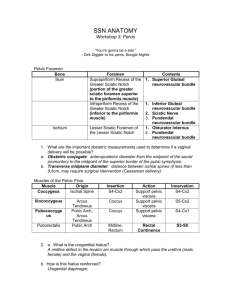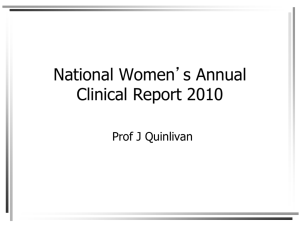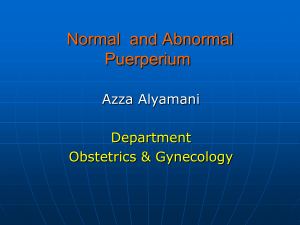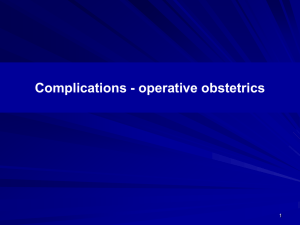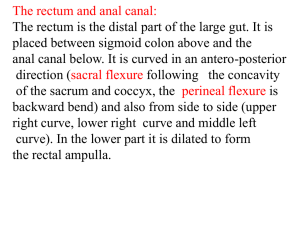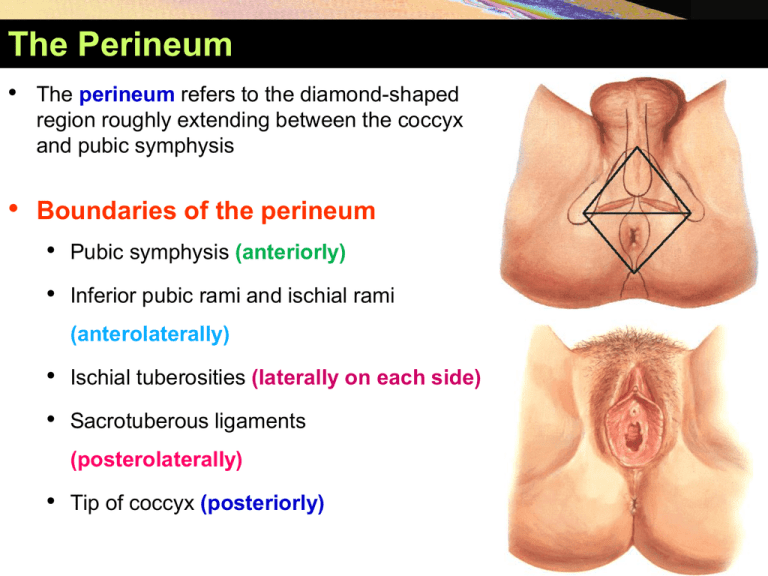
The Perineum
• The perineum refers to the diamond-shaped
region roughly extending between the coccyx
and pubic symphysis
•
Boundaries of the perineum
• Pubic symphysis (anteriorly)
• Inferior pubic rami and ischial rami
(anterolaterally)
• Ischial tuberosities (laterally on each side)
• Sacrotuberous ligaments
(posterolaterally)
• Tip of coccyx (posteriorly)
The Perineum
The Perineum
The Perineum
It is generally defined as the surface region in
both males and females between the pubic
symphysis and the coccyx.
is the region of the body inferior to the pelvic
diaphragm and between the legs.
It is a diamond-shaped area on the inferior
surface of the trunk that includes the anus and,
in females, the vagina.
Its definition varies: it can refer to only the
superficial structures in this region, or it can be
used to include both superficial and deep
structures.
The perineum corresponds to the outlet of the
pelvis.
The Perineum
It is an erogenous zone for both males and
females.
Perineal tears and episiotomy often occur in
childbirth with first-time deliveries.
The anogenital distance is a measure of the
distance between the anus and the base of the
penis or vagina.
The human perineum is twice as long in males
as in females.
Measuring the anogenital distance in neonatal
humans has been suggested as a noninvasive
method to determine male feminisation and
thereby predict neonatal and adult reproductive
disorders.
The Perineum
A line connecting the two ischial
tuberosities divides the perineum in two
triangular regions.
Urogenital region (triangle)
Pierced by:
Urethra
The vagina (female)
Serves as attachment site:
For the external genitalia
Contains:
The external genitalia
Anal region (triangle)
Contans:
Anal canal
Ischiorectal fossae
The Perineum
• The perineum lies inferior to the pelvic floor
between the lower limbs. Its margin is
formed by the pelvic outlet.
• An imaginary line between the ischial
tuberosities divides the perineum into two
triangular regions:
• Anteriorly, the urogenital triangle
• contains :
• The roots of the external genitalia and,
•
in women, the openings of the urethra
and the vagina .
In men, the distal part of the urethra is
enclosed by erectile tissues and opens
at the end of the penis.
• Posteriorly, the anal triangle contains the
anal aperture.
The Perineum
The Perineum- Anal Region (Triangle)
The Perineum
The Perineum
The Perineum- Urogenital Region (Triangle)
Urogenital diaphragm
Formed by muscular shelf that stretches between
the conjoint ischiopubic rami of the two sides.
It is pierced by the urethra and, in the female, also
by the vagina.
Serves as a foundation for the attachment of the
external genitalia.
Fascias attached to the urogenital diaphragm
define two spaces of considerable anatomic and
clinical importance.
Superficial perineal space
Deep perineal space
The Perineum
Urogenital diaphragm
Fascias attached to the urogenital
diaphragm define two spaces of
considerable anatomic and clinical
importance.
Superficial perineal space
Deep perineal space
The Perineum- Urogenital Triangle
Superficial perineal space
is between superficial perineal
(Colles’) fascia (continuation of Scarpa)
and perineal membrane (the inferior
fascia of the urogenital diaphragm).
The Perineum- Urogenital Triangle
Contents of superficial
perineal space-FEMALE
The labia majora
The labia minora
The bulb of the vestibule
The clitoris
The female urethra
Greater vestibular (Bartholin’s) gland
Superficial transverse perineal muscle
Bulbospongiosus muscle
Ischiocavernosus muscle
Note that these muscles are invested
by the deep perineal (investing or
Gallaudet’s) facia
The Perineum- Urogenital Triangle
Contents of superficial perineal space-FEMALE
The Perineum- Urogenital Triangle
Contents of superficial
perineal space-MALE
Bulb of penis
Crus of penis
Superficial transverse perineal
muscle
Bulbospongiosus muscle
Ischiocavernosus muscle
Note that these muscles are
invested by the deep perineal
(investing or Gallaudet’s) facia
The Perineum- Urogenital Triangle
Contents of superficial perineal space-MALE
The Perineum- Urogenital Triangle
Contents of superficial
perineal space in both sexes
• The superficial perineal muscles
• Superficial transverse perineal
•
•
muscle
Ischiocavernosus muscle
Bulbospongiosus muscle
• Deep perineal fascia (investing
fascia – Gallaudet’s fascia)
• Invests the superficial
perineal muscles
• Branches of the internal pudendal
vessels and pudendal nerves
Contents of superficial
perineal space in both sexes
The Perineum- Urogenital Triangle
The Perineum- Urogenital Triangle
Deep perineal space
is the space between the inferior
and superior fascias of the
urogenital diaphragm.
The Perineum- Urogenital Triangle
Deep perineal space
Is surrounded by the inferior and
superior facias of the pelvic diaphragm.
Is completely closed.
It does not communicate with other
perineal or pelvic spaces.
Superior facia of pelvic diaphragm
forms the anterior recess of the
ischiorectal fossa.
It is completely filled with the deep
perineal muscles.
The Perineum- Urogenital Triangle
Contents of the deep perineal
pouch
• In males
•
•
•
Membranous part of the urethra
Bulbourethral glands
In females
•
•
Proximal part of the urethra
Part of vagina
The Perineum- Urogenital Triangle
• Deep perineal space (pouch)
• External urethral sphincter muscle
• Deep transverse perineal muscles
• Two muscles form the urogenital
diaphragm
• Therefore the deep perineal pouch
contains the urogenital diaphragm in
both sexes
• Urogenital diaphragm is used to refer
to a layer of the pelvis that separates the
deep perineal pouch from the upper
pelvis, such a discrete border of the sac
probably does not exist
The Perineum- Urogenital Diaphragm
• External urethral
sphincter muscle
• Deep transverse
perineal muscles
The Perineum- Urogenital Diaphragm
The Perineum- Urogenital Diaphragm
The Perineum- Deep Perineal Space (Pouch)
The perineal membrane is related above to a thin space called
the deep perineal pouch (deep perineal space), which contains
a layer of skeletal muscle and various neurovascular elements.
FEMALE
MALE
Muscles within the Deep Perineal Pouch
The Perineum- Anal Region (Triangle)
Pelvic diaphragm
Formed by levator ani and
coccygeus mucles.
Contains:
Ischiorectal (ischioanal)
fossa
Pudendal canal
Anal canal
External anal sphincter
The Perineum- Anal Region (Triangle)
The Perineum- Anal Region (Triangle)
The Perineum- Anal Region (Triangle)
Levator ani muscle
Puborectalis
Pubococcygeus
Iliococcygeus
The Perineum- Anal Region (Triangle)
Levator ani muscle
Originates along a semicircular line that
skirts the pelvic walls from the pelvic
surface of the body of the pubis to the
ischial spine.
Attaches to a bandlike reinforcement in the
obturator facia , arcus tendineus
(tendinous arch of the levator ani) and
perineal structures.
The fibers of the muscle sweep backward
as well as downward with varying degrees
of obliquity.
The Pelvic Diaphragm and Its Components
Sphincter Vaginae (or
Levator Prostatae)
Levator Prostatae or
Sphincter Vaginae
Pubic Symphysis
Urethra
Vagina
Rectum
Puborectalis
Pubococcygeus
Perineal
Body
Puborectalis
Pubococcygeus
Obturator
Internus
Coccyx
Iliococcygeus
Coccygeus
Iliococcygeus
Sacrum
Superior View
Coccyx
Coccygeus
Inferior View
The Perineum
Perineal body (central tendon of perineum-centrum tendineum):
The midpoint of the line joining the ischial tuberosities.
Located in the median plane anterior to the anal canal and inferior to the
inferior fascia of the urogenital diaphragm (perineal membrane)
Lies deep to the subcutaneous tissue.
The Perineum
Perineal body
Contains collagenous and elastic fibers, as well as smooth and skeletal muscle
fibers.
The attachment point of several perineal muscles:
Bulbospongiosus
External anal sphincter muscle
Superficial and deep transverse perineal muscles
The Perineum
Perineal body
(central tendon of perineum-centrum tendineum):
The midpoint of the line joining the ischial
tuberosities.
Located in the median plane anterior to the anal
canal and inferior to the inferior fascia of the
urogenital diaphragm (perineal membrane)
Lies deep to the subcutaneous tissue.
Contains collagenous and elastic fibers, as well
as smooth and skeletal muscle fibers.
The attachment point of several perineal
muscles:
Bulbospongiosus
External anal sphincter muscle
Superficial and deep transverse perineal
muscles
The Perineum
Sphincter of urethra (male) or
urethrovaginal sphincter (female)
Bulbocavernousus
Deep transverse muscles of perineum
Superficial transverse muscle of perineum
Levator ani
Sphincter ani externus
The Episiotomy
is an incision of the perineum to enlarge the
vagina for childbirth.
This incision can be midline, from vagina to
the anus or be a midlateral incision, from
vagina to the thigh.
The importance of this incision is described
in degrees. A first degree means that only the
skin and mucous membranes are affected.
In the case of a second or a third degree
perineal muscles are cut too. It is not
uncommon that the cut extends to reach and
even tear the anal sphincter (fourth degree).
Episiotomies are practice with a pair of
scissors, just before the release of the baby's
head.
The Episiotomy
The Episiotomy
The Perineum- Anal Region (Triangle)
Ischiorectal (ischioanal) fossa
Roughly wedgeshaped spaces on each
side of the anal canal.
The anal canal and perineal body
separate the fossae of the two sides.
The only communication between them
is posteriorly through a narrow potential
space located deep to the fibers of the
sphincter ani externus.
The Perineum- Anal Region (Triangle)
Ischiorectal (ischioanal) fossa
Lateral wall:
More or less vertical, formed by the
obturator internus muscle.
Base:
Perineal skin
Superomedial wall:
Is sloping and formed by the levator
ani muscle.
is sealed off above by the fusion of the
inferior facia of the pelvic diaphragm to
the obturator facia.
The Perineum- Ischiorectal Fossa
• Laterally bounded by the
obturator internus muscles and
fascia covering it
• Pudendal canal lies on this
wall
• Medially bounded by the external
anal sphincter
• Posteriorly bounded by the
gluteus maximus muscle
• Anteriorly bounded by the bodies
of the pubic bones
The Perineum- Anal Region (Triangle)
Pudendal canal
Formation:
The facial sheath of the nerve and
vessels is fused to the obturator
fascia and is called the pudendal
canal.
Contents:
Pudendal nerve
Internal pudendal artery
Internal pudendal vein
The Perineum- Anal Region (Triangle)
Pudendal canal
Formation:
The facial sheath of the
nerve and vessels is fused
to the obturator fascia and
is called the pudendal
canal.
Contents:
Pudendal nerve
Internal pudendal artery
Internal pudendal vein
The Perineum- Pudandal Block
The pudendal nerve is within the pudendal
canal as the nerve wraps itself around the
ischial spine and before it sends out its
branches.
The palpating finger is used to locate the
ischial spine and sacrospinous ligament per
vaginam.
The needle is inserted through the vaginal
wall, is directed towards the spine and then
passed through the sacrospinous ligament.
As soon as the needle has passed through
the ligament, a loss of resistance is felt. At this
point anaesthetic solution is injected.
The Lumbar Plexus
The Lumbal Plexus
The Lumbal Plexus
The Sacral and Coccygeal Plexus
The Sacral Plexus
The Internal Iliac Artery
The Arteries and Veins of Pelvis
The Arteries and Veins of Pelvis
The Arteries and Veins of Pelvis
The Arteries and Veins of Pelvis
The Arterial Supply to the Prostate
The Arterial and Veins of Perineum
The Arterial and Veins of Perineum
The Arterial and Veins of Perineum
The Arterial and Veins of Perineum
The Arterial and Veins of Perineum
Lymphatic Drainage of Pelvis and Perineum
Para-aortic
Rules:
•
External iliac
Superficial Inguinal
•
Lymphatics drain
toward lymph
nodes along
internal iliac veins,
except for the
ovary (para-aortic
nodes), and
superior portion of
the rectum
(inferior
mesenteric nodes)
Perineum drains
to superficial
inguinal nodes
Internal iliac


